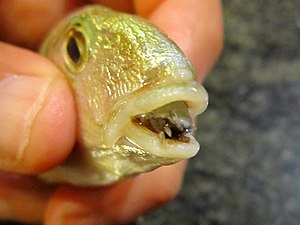Parasitisme
Indenfor evolutionær økologi er parasitisme et symbiotisk forhold mellem to arter, hvor en organisme, parasitten, lever på eller i en anden organisme værten, forårsager værten en form for skade, og er tilpasset strukturelt til dette liv.[1]
Henvisninger
- ^ Poulin 2007, s. 4–5.
Kilder
- Combes, Claude (2005). The Art of Being a Parasite. The University of Chicago Press. ISBN 978-0-226-11438-5.
- Desowitz, Robert (1998). Who Gave Pinta to the Santa Maria?. Harvest Books. ISBN 978-0-15-600585-2.
- Poulin, Robert (2007). Evolutionary Ecology of Parasites. Princeton University Press. ISBN 978-0-691-12085-0.
- Zimmer, Carl (2001). Parasite Rex. Free Press. ISBN 978-0-7432-0011-0.
| Spire Denne artikel om dyr er en spire som bør udbygges. Du er velkommen til at hjælpe Wikipedia ved at udvide den. |
|
Medier brugt på denne side
a black paw
Forfatter/Opretter: Marco Vinci, Licens: CC BY-SA 3.0
Cymothoa exigua, or the tongue-eating louse, is a parasitic crustacean of the family Cymothoidae. The parasite enters fish (here a Sand steenbras, Lithognathus mormyrus) through the gills and then attaches itself to the fish's tongue.


